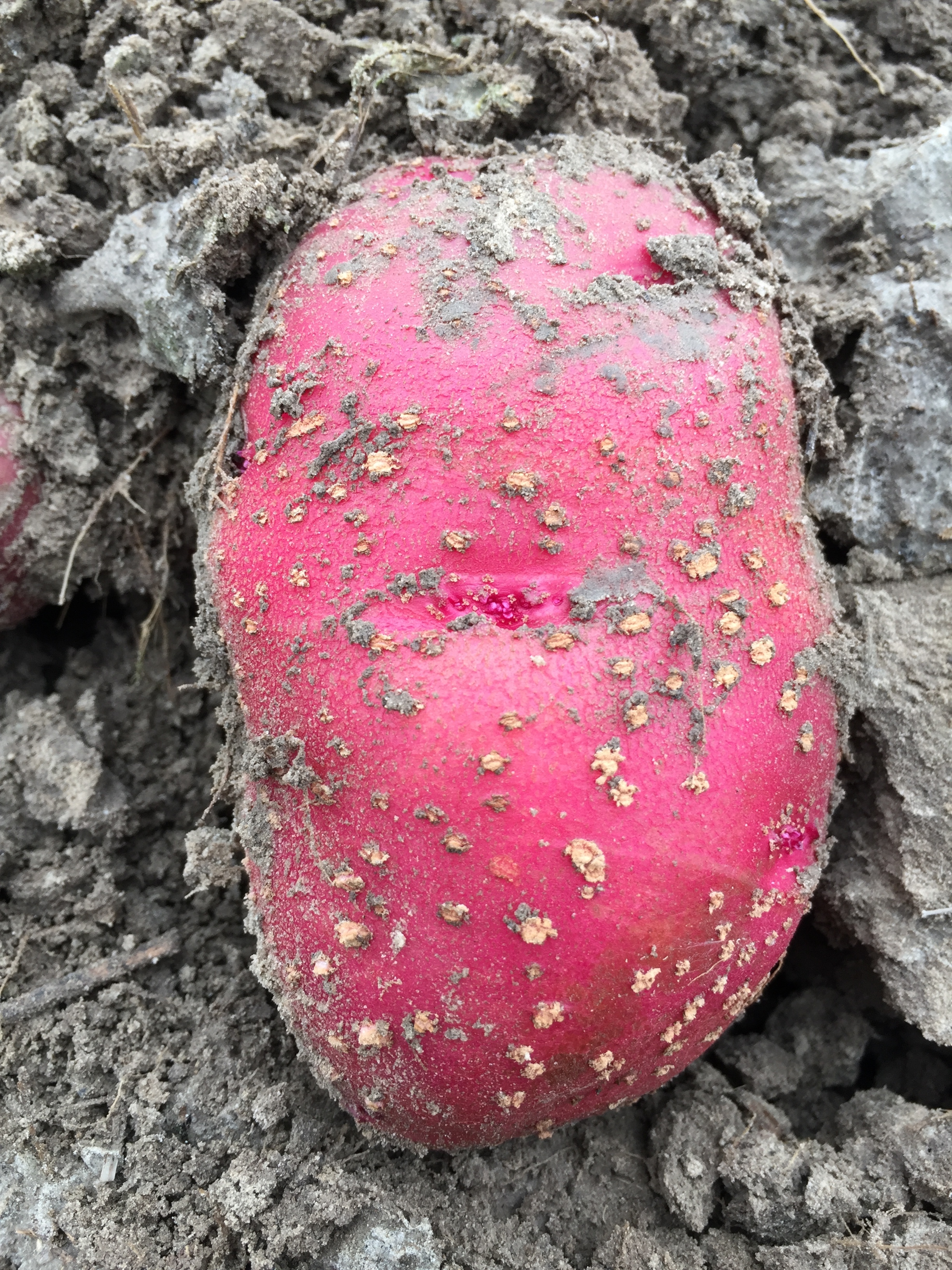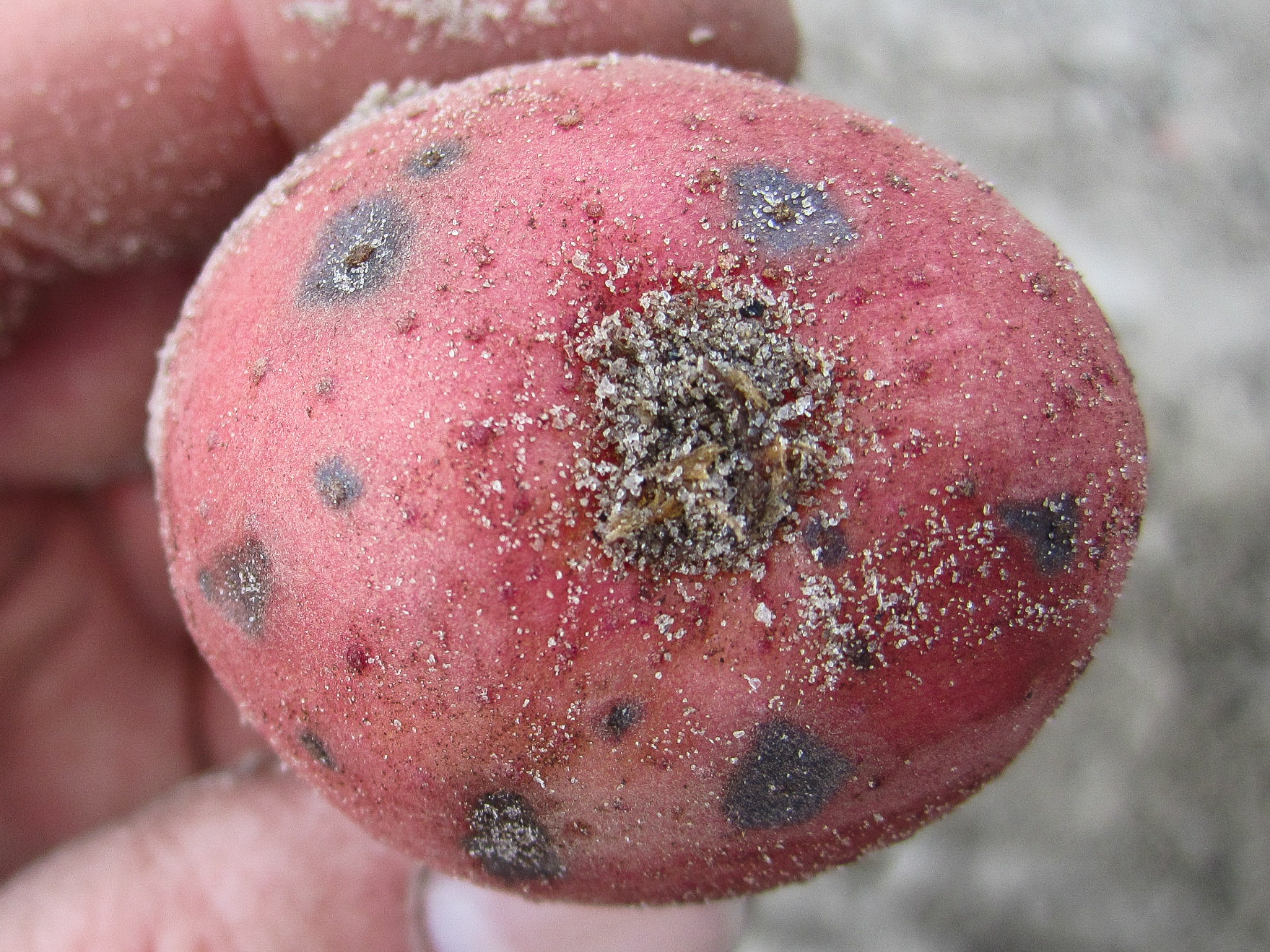This article appears in the December 2017 issue of Potato Grower.
The appearance of potato tubers is a key characteristic determining consumer buying on the fresh market. Blemishes may discourage purchases or entice the consumer to switch to a different market class.
One unsightly problem affecting potatoes is lenticel spot or lenticel rot. Lenticels are breathing pores that appear as tiny slits on the tuber surface. They are the gateway for the gas exchange (primarily to take in oxygen and exchange carbon dioxide) in the tuber necessary for growth and development. Potato tubers have 28 to 274 lenticels per tuber. Lenticel numbers will vary by cultivar and tuber size. As tubers rapidly grow, the rupturing of the periderm often forms more lenticels.
How Lenticel Spot Develops
Lenticel spot is a common physiological disorder that occurs when lenticels enlarge. Potato tubers are living organisms, so when they are unable to obtain sufficient oxygen, the lenticels enlarge to acquire more oxygen.
 When soil is waterlogged for a period of time, the lenticels become enlarged and they can appear to be like small white “popcorn” on the tuber surface. When the enlarged lenticels dry, they may appear as small scab lesions. Other conditions that cause reduced oxygen availability, and thus lead to enlarged lenticels, are dry soil that is highly compacted, elevated CO2 concentrations in storage or a water film on the tuber after washing.
When soil is waterlogged for a period of time, the lenticels become enlarged and they can appear to be like small white “popcorn” on the tuber surface. When the enlarged lenticels dry, they may appear as small scab lesions. Other conditions that cause reduced oxygen availability, and thus lead to enlarged lenticels, are dry soil that is highly compacted, elevated CO2 concentrations in storage or a water film on the tuber after washing.
Lenticel spot not only is unsightly; it also may allow pathogen entry when lenticels are enlarged. This can lead to pathogen infection in and around the lenticels. Research has focused on bacterial soft rot (Pectobacterium carotovora) accumulation in lenticels, most likely because it is the most common pathogen found within the lenticels.
Lenticels have been reported to provide an entry point for other pathogens of potato tubers, such as Dickeya species, powdery scab (Spongospora subterranea), late blight (Phytophthora infestans), pythium leak (Pythium ultimum), pink rot (Phytophthora erythroseptica) and common scab (Streptomyces scabies).
Effects of Lenticel Infections
The infections of lenticels may result in visible lesions, breakdown of tubers in storage or latent pathogens surviving and expressing themselves in the grocery store or in seed. The spotted lenticels are a result of the latent phase caused when the lenticel closes and a corky layer forms over the bacterium but the tuber is not broken down.
These small, localized areas of lenticel spot typically do not penetrate into the tuber more than 3 to 4 millimeters and typically are noticed a few days after harvest or packaging. The spots with halos around them are usually the result of bacterial soft rot multiplying somewhat in the lenticel, causing sunken and rotten tissue that is tan to dark brown, circular and surrounding the lenticels in a halo-like appearance.
Research has reported that Pectobacterium carotovora (bacterial soft rot) can survive in the lenticels throughout the storage season. Rapid bacteria multiplication and rotting of the tuber is most likely to occur when oxygen is inadequate. When this happens, bacterial soft rot will occur quickly, especially in warm conditions.
Reducing Lenticel Spot
Tubers being moved from the field to storage or to a packaging facility likely will encounter changes in temperature, moisture levels and air quality that may encourage lenticels to open and bacteria to multiply. In a wet year, many harvested potatoes are likely to have lenticel spot.
 To mitigate problems with lenticel spot, avoid harvesting low areas in the field. When piling tubers, be sure to minimize bruising, and dry the tubers as quickly as possible to avoid lenticels staying too wet or being exposed to elevated CO2 levels. Suberize potatoes for two to three weeks with fresh air at 50 to 55 degrees, with 95 to 99 percent relative humidity. Proper suberization will close lenticels quickly, protecting the tuber from pathogen entry.
To mitigate problems with lenticel spot, avoid harvesting low areas in the field. When piling tubers, be sure to minimize bruising, and dry the tubers as quickly as possible to avoid lenticels staying too wet or being exposed to elevated CO2 levels. Suberize potatoes for two to three weeks with fresh air at 50 to 55 degrees, with 95 to 99 percent relative humidity. Proper suberization will close lenticels quickly, protecting the tuber from pathogen entry.
One mistake likely to increase lenticel spots in the packaging process is not sufficiently drying washed potatoes. Typically, washed potatoes are stored in a cooler. This slows disease development, but it also slows drying time and suberization. A water film around the tuber may lead to anaerobic conditions, causing lenticels to open and latent bacteria to multiply. Potatoes that are shipped with a water film can break down completely in transit under the right conditions and become a stinky mess; the warmer the shipping temperature, the more rapid the breakdown.
Management Tips
Managing lenticel spot can be challenging; however, here are some management tips to help reduce lenticel spot in the field and in storage.
Management in the field and at harvest:
- If possible, keep the available soil moisture below 90 percent.
- Harvest when temperatures are between 50 and 65 degrees.
- Avoid harvesting following heavy rains or in water-logged areas.
- Ensure harvesting equipment is clean and sanitized.
- Minimize bruising.
- Properly suberize tubers.
- Never wash tubers before placing in storage.
Storage management practices:
- Prevent the accumulation of CO2 and condensation in storage by ensuring good air movement.
- Frequently clean and sanitize fluming systems and water.
- Clean water with an effective biocide.
- Clean and sanitize all equipment to prevent bacteria from spreading.
- Dry washed tubers with forced hot air as quickly as possible to remove the film of water on the tubers.
- Ensure that bags and shipping containers are well-ventilated.
Andy Robinson is an extension potato agronomist with North Dakota State University and the University of Minnesota. Gary Secor is a professor and plant pathologist at North Dakota State University.